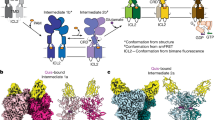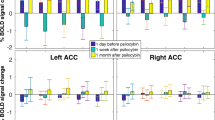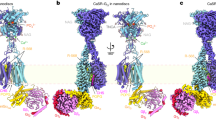Abstract
Structural analysis of class B G-protein-coupled receptors (GPCRs), cell-surface proteins that respond to peptide hormones, has been restricted to the amino-terminal extracellular domain, thus providing little understanding of the membrane-spanning signal transduction domain. The corticotropin-releasing factor receptor type 1 is a class B receptor which mediates the response to stress and has been considered a drug target for depression and anxiety. Here we report the crystal structure of the transmembrane domain of the human corticotropin-releasing factor receptor type 1 in complex with the small-molecule antagonist CP-376395. The structure provides detailed insight into the architecture of class B receptors. Atomic details of the interactions of the receptor with the non-peptide ligand that binds deep within the receptor are described. This structure provides a model for all class B GPCRs and may aid in the design of new small-molecule drugs for diseases of brain and metabolism.
This is a preview of subscription content, access via your institution
Access options
Subscribe to this journal
Receive 51 print issues and online access
$199.00 per year
only $3.90 per issue
Buy this article
- Purchase on Springer Link
- Instant access to full article PDF
Prices may be subject to local taxes which are calculated during checkout





Similar content being viewed by others
References
Gether, U. Uncovering molecular mechanisms involved in activation of G protein-coupled receptors. Endocr. Rev. 21, 90–113 (2000)
Lagerström, M. C. & Schiöth, H. B. Structural diversity of G protein-coupled receptors and significance for drug discovery. Nature Rev. Drug Discov. 7, 339–357 (2008)
Venkatakrishnan, A. J. et al. Molecular signatures of G-protein-coupled receptors. Nature 494, 185–194 (2013)
Bhavsar, S., Mudaliar, S. & Cherrington, A. Evolution of exenatide as a diabetes therapeutic. Curr. Diabetes Rev. 9, 161–193 (2013)
Berg, C., Neumeyer, K. & Kirkpatrick, P. Teriparatide. Nature Rev. Drug Discov. 2, 257–258 (2003)
Rosenbaum, D. M., Rasmussen, S. G. F. & Kobilka, B. K. The structure and function of G-protein-coupled receptors. Nature 459, 356–363 (2009)
Wang, C. et al. Structure of the human smoothened receptor bound to an antitumour agent. Nature 497, 338–343 (2013)
Congreve, M., Langmead, C. & Marshall, F. H. The use of GPCR structures in drug design. Adv. Pharmacol. 62, 1–36 (2011)
Pioszak, A. A., Parker, N. R., Suino-Powell, K. & Xu, H. E. Molecular recognition of corticotropin-releasing factor by its G-protein-coupled receptor CRFR1. J. Biol. Chem. 283, 32900–32912 (2008)
Grace, C. R. R. et al. NMR structure and peptide hormone binding site of the first extracellular domain of a type B1 G protein-coupled receptor. Proc. Natl Acad. Sci. USA 101, 12836–12841 (2004)
Runge, S., Thøgersen, H., Madsen, K., Lau, J. & Rudolph, R. Crystal structure of the ligand-bound glucagon-like peptide-1 receptor extracellular domain. J. Biol. Chem. 283, 11340–11347 (2008)
Pioszak, A. A. & Xu, H. E. Molecular recognition of parathyroid hormone by its G protein-coupled receptor. Proc. Natl Acad. Sci. USA 105, 5034–5039 (2008)
ter Haar, E. et al. Crystal structure of the ectodomain complex of the CGRP receptor, a class-B GPCR, reveals the site of drug antagonism. Structure 18, 1083–1093 (2010)
Kumar, S., Pioszak, A., Zhang, C., Swaminathan, K. & Xu, H. E. Crystal structure of the PAC1R extracellular domain unifies a consensus fold for hormone recognition by class B G-protein coupled receptors. PLoS ONE 6, e19682 (2011)
Koth, C. M. et al. Molecular basis for negative regulation of the glucagon receptor. Proc. Natl Acad. Sci. USA 109, 14393–14398 (2012)
Perrin, M. H. & Vale, W. W. Corticotropin releasing factor receptors and their ligand family. Ann. NY Acad. Sci. 885, 312–328 (1999)
Bale, T. L. & Vale, W. W. CRF and CRF receptors: role in stress responsivity and other behaviors. Annu. Rev. Pharmacol. Toxicol. 44, 525–557 (2004)
Hemley, C. F., McCluskey, A. & Keller, P. A. Corticotropin releasing hormone–a GPCR drug target. Curr. Drug Targets 8, 105–115 (2007)
Chen, Y. L. et al. 2-aryloxy-4-alkylaminopyridines: discovery of novel corticotropin-releasing factor 1 antagonists. J. Med. Chem. 51, 1385–1392 (2008)
Hoare, S. R. et al. Allosteric ligands for the corticotropin releasing factor type 1 receptor modulate conformational states involved in receptor activation. Mol. Pharmacol. 73, 1371–1380 (2008)
Zorrilla, E. P. & Koob, G. F. Progress in corticotropin-releasing factor-1 antagonist development. Drug Discov. Today 15, 371–383 (2010)
Serrano-Vega, M. J., Magnani, F., Shibata, Y. & Tate, C. G. Conformational thermostabilization of the β1-adrenergic receptor in a detergent-resistant form. Proc. Natl Acad. Sci. USA 105, 877–882 (2008)
Shibata, Y. et al. Thermostabilization of the neurotensin receptor NTS1. J. Mol. Biol. 390, 262–277 (2009)
Lebon, G., Bennett, K., Jazayeri, A. & Tate, C. G. Thermostabilisation of an agonist-bound conformation of the human adenosine A2A receptor. J. Mol. Biol. 409, 298–310 (2011)
Piserchio, A., Bisello, A., Rosenblatt, M., Chorev, M. & Mierke, D. F. Characterization of parathyroid hormone/receptor interactions: structure of the first extracellular loop. Biochemistry 39, 8153–8160 (2000)
Wootten, D., Simms, J., Miller, L. J., Christopoulos, A. & Sexton, P. M. Polar transmembrane interactions drive formation of ligand-specific and signal pathway-biased family B G protein-coupled receptor conformations. Proc. Natl Acad. Sci. USA 110, 5211–5216 (2013)
Katritch, V., Cherezov, V. & Stevens, R. C. Diversity and modularity of G protein-coupled receptor structures. Trends Pharmacol. Sci. 33, 17–27 (2012)
Mann, R. J., Al-Sabah, S., De Maturana, R. L., Sinfield, J. K. & Donnelly, D. Functional coupling of Cys-226 and Cys-296 in the glucagon-like peptide-1 (GLP-1) receptor indicates a disulfide bond that is close to the activation pocket. Peptides 31, 2289–2293 (2010)
Chien, E. Y. T. et al. Structure of the human dopamine D3 receptor in complex with a D2/D3 selective antagonist. Science 330, 1091–1095 (2010)
Ballesteros, J. A. & Weinstein, H. Integrated methods for the construction of three-dimensional models and computational probing of structure-function relations in G protein-coupled receptors. Methods Neurosci. 25, 366–428 (1995)
Rasmussen, S. G. F. et al. Crystal structure of the β2 adrenergic receptor–Gs protein complex. Nature 477, 549–555 (2011)
Schipani, E., Kruse, K. & Jüppner, H. A constitutively active mutant PTH-PTHrP receptor in Jansen-type metaphyseal chondrodysplasia. Science 268, 98–100 (1995)
Heller, R. S., Kieffer, T. J. & Habener, J. F. Point mutations in the first and third intracellular loops of the glucagon-like peptide-1 receptor alter intracellular signaling. Biochem. Biophys. Res. Commun. 223, 624–632 (1996)
Hjorth, S. A., Orskov, C. & Schwartz, T. W. Constitutive activity of glucagon receptor mutants. Mol. Endocrinol. 12, 78–86 (1998)
Vohra, S. et al. Similarity between class A and class B G-protein-coupled receptors exemplified through calcitonin gene-related peptide receptor modelling and mutagenesis studies. J. R. Soc. Interface 10, 20120846 (2013)
Hoare, S. R. J. et al. Single amino acid residue determinants of non-peptide antagonist binding to the corticotropin-releasing factor1 (CRF1) receptor. Biochem. Pharmacol. 72, 244–255 (2006)
Gardella, T. J., Luck, M. D., Fan, M. H. & Lee, C. Transmembrane residues of the parathyroid hormone (PTH)/PTH-related peptide receptor that specifically affect binding and signaling by agonist ligands. J. Biol. Chem. 271, 12820–12825 (1996)
Conner, A. C. et al. A key role for transmembrane prolines in calcitonin receptor-like receptor agonist binding and signalling: implications for family B G-protein-coupled receptors. Mol. Pharmacol. 67, 20–31 (2005)
Chugunov, A. O. et al. Evidence that interaction between conserved residues in transmembrane helices 2, 3, and 7 are crucial for human VPAC1 receptor activation. Mol. Pharmacol. 78, 394–401 (2010)
Ganguli, S. C. et al. Protean effects of a natural peptide agonist of the G protein-coupled secretin receptor demonstrated by receptor mutagenesis. J. Pharmacol. Exp. Ther. 286, 593–598 (1998)
Robertson, N. et al. The properties of thermostabilised G protein-coupled receptors (StaRs) and their use in drug discovery. Neuropharmacology 60, 36–44 (2011)
Söding, J. Protein homology detection by HMM–HMM comparison. Bioinformatics 21, 951–960 (2005)
Krogh, A., Larsson, B., von Heijne, G. & Sonnhammer, E. L. L. Predicting transmembrane protein topology with a hidden Markov model: application to complete genomes. J. Mol. Biol. 305, 567–580 (2001)
Kawate, T. & Gouaux, E. Fluorescence-detection size-exclusion chromatography for precrystallization screening of integral membrane proteins. Structure 14, 673–681 (2006)
Caffrey, M. & Cherezov, V. Crystallizing membrane proteins using lipidic cubic mesophases. Nature Protocols 4, 706–731 (2009)
Kabsch, W. XDS. Acta Crystallogr. D 66, 125–132 (2010)
Leslie, A. G. W. & Powell, H. R. Processing diffraction data with Mosflm. Evolv. Methods Macromol. Crystallogr. 245, 41–51 (2007)
Winn, M. D. et al. Overview of the CCP4 suite and current developments. Acta Crystallogr. D 67, 235–242 (2011)
Hanson, M. A. et al. Crystal structure of a lipid G protein-coupled receptor. Science 335, 851–855 (2012)
McCoy, A. J. et al. Phaser crystallographic software. J. Appl. Cryst. 40, 658–674 (2007)
Emsley, P., Lohkamp, B., Scott, W. G. & Cowtan, K. Features and development of Coot. Acta Crystallogr. D 66, 486–501 (2010)
Adams, P. D. et al. PHENIX: a comprehensive Python-based system for macromolecular structure solution. Acta Crystallogr. D 66, 213–221 (2010)
Murshudov, G. N. et al. REFMAC5 for the refinement of macromolecular crystal structures. Acta Crystallogr. D 67, 355–367 (2011)
Haddadian, E. J. et al. Automated real-space refinement of protein structures using a realistic backbone move set. Biophys. J. 101, 899–909 (2011)
Chen, V. B. et al. MolProbity: all-atom structure validation for macromolecular crystallography. Acta Crystallogr. D 66, 12–21 (2010)
Acknowledgements
We thank G. Evans, R. Owen and D. Axford for their support. We are grateful to A. Leslie, R. Read and A. McCoy for advice on data collection and structure determination. We thank R. Henderson, A. Leslie, C. Tate as well as F. Blaney, B. Tehan, R. Miller, F. Deflorian and other colleagues for suggestions and comments.
Author information
Authors and Affiliations
Contributions
J.K. carried out the conformational thermostabilization and pharmacological characterization of the constructs and determined the stability of the StaR in a panel of reagents/additives to aid purification and crystallization. A.J. constructed the T4 lysozyme fusion proteins and identified the usefulness of the fusion into intracellular loop 2. K.H. designed and characterized truncation constructs, designed the final T4 lysozyme fusion construct, established procedures for, and carried out expression and purification, established the platform/protocols for and carried out lipidic cubic phase (LCP) crystallization, collected and processed X-ray diffraction data, solved and refined the structure. R.K.Y.C. performed expression and purification, optimized purification and grew crystals in LCP for data collection of the final construct, collected X-ray diffraction data and solved and refined the structure. A.S.D. was involved in construct design, established the platform/protocols for, and carried out LCP crystallization, collected and processed X-ray diffraction data and solved and refined the structure. Computational analysis of the structure and modelling was carried out by A.B. Project management was carried out by A.J., R.M.C., M.W. and F.H.M. The manuscript was prepared by K.H., R.K.Y.C., A.B., J.K., A.J. and F.H.M.
Corresponding author
Ethics declarations
Competing interests
The authors are employees and shareholders of Heptares Therapeutics Ltd, a GPCR drug discovery company using structure-based drug design techniques.
Supplementary information
Supplementary Information
This file contains Supplementary Figures 1-11 and Supplementary Tables 1-6. (PDF 1690 kb)
Rights and permissions
About this article
Cite this article
Hollenstein, K., Kean, J., Bortolato, A. et al. Structure of class B GPCR corticotropin-releasing factor receptor 1. Nature 499, 438–443 (2013). https://doi.org/10.1038/nature12357
Received:
Accepted:
Published:
Issue Date:
DOI: https://doi.org/10.1038/nature12357
This article is cited by
-
Class B1 GPCR activation by an intracellular agonist
Nature (2023)
-
Structure-based drug discovery of a corticotropin-releasing hormone receptor 1 antagonist using an X-ray free-electron laser
Experimental & Molecular Medicine (2023)
-
Ligand binding at the protein–lipid interface: strategic considerations for drug design
Nature Reviews Drug Discovery (2021)
-
G protein-coupled receptors: structure- and function-based drug discovery
Signal Transduction and Targeted Therapy (2021)
-
Advances in therapeutic peptides targeting G protein-coupled receptors
Nature Reviews Drug Discovery (2020)
Comments
By submitting a comment you agree to abide by our Terms and Community Guidelines. If you find something abusive or that does not comply with our terms or guidelines please flag it as inappropriate.



